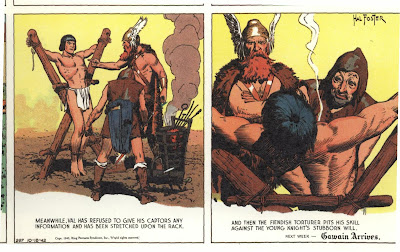Over the years, the mantle of the Phantom is passed from father to son. But only a few select people know that. The Phantom becomes known as "The Ghost Who Walks" and develops a legend of immortality that awes the good guys and really freaks out the bad guys.
The Phantom
While the Phantom was fighting villainy in modern times, artist Hal Foster was tossing Arthurian knight Prince Valiant up against various bad guys in 6th Century Europe (with occasional trips to the mid-East and Africa). It's an element from a story arc from 1942 that makes me think Foster might have been aware of the Phantom's back story.
Prince Valiant
It turns out that the guy (named Julian) is a descendant of a wounded soldier left behind when the Romans pulled out. He recovered and since then, the job of sentry has been passed on from father to son.
Valiant goes on a scouting mission into Scotland, where he's caught by the Picts. He's tortured horribly before being rescued by his friend Sir Gawain.
Gawain gets Valiant back to the wall, but they're cornered by the villains. But then Julian walks out. We find out the Picts think he's immortal (just like, for instance, the Phantom) and they back off.
Julian mirrors the Phantom very closely in that regard. Of course, there's an excellent chance it's just a coincidence. But then again, maybe Foster was following the adventures of one of his competitors and borrowed an idea.
In either case, the whole Hadrian's wall sequence from Prince Valiant is (as is typical of Foster's work) breathtakingly beautiful to look at and a well-constructed story to boot. If Foster did borrow the idea of perceived immortality from Lee Falk, it was a harmless enough bit of shoplifting. The stories, main characters and visual styles of the two men are otherwise clearly unique in their own rights.
Besides--who knows? Maybe a few centuries after King Arthur's kingdom fell, it was a descendant of Julian who became the first Phantom.












No comments:
Post a Comment